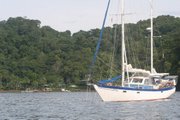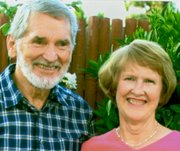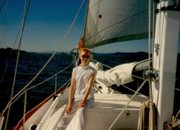January 17-February 3: A taxi picked up Thom and Allen at midday to drive
them back across the Isthmus to the airport and their return to San
Francisco. (And that's another story. Because of various delays, they
arrived in SF not on Wednesday night but on Friday afternoon.)
We soon came to appreciate so much about Shelter Bay Marina. To illustrate
how grateful we can be for minor conveniences, we were delighted to find a
small self-service laundry room at the marina. While there's much to be
said for having someone else always do the laundry for us, we'd prefer to be
responsible for bleach spots on our clothing or missing articles; and it's
easier to fold the laundry in the first place than to unfold and refold it
because it won't fit into our small designated spaces.
Another asset here is the access to WiFi for Internet. While this wasn't
the first marina where we've had this service, this one was the most
consistently reliable.
The major inconvenience of being at Shelter Bay is its location so far from
Colón, where all the services are available. The marina does have a van
that has two scheduled trips into town each day, the one in the morning
going for four hours and, in the afternoon, for two hours. Though the
marina is only 12 miles from town, the travel time is usually extended for
as much as 30-45 minutes each way because the only route to town is across
the swinging bridge at Gatún Locks. If a transiting boat is entering or
exiting the locks, the bridge must be swung open, stopping all road traffic.
When the bridge is passable, only one lane may cross at a time. Rarely did
we ever get to the bridge and not have a delay of some duration.
But this out-of-the-way location also resulted in making this marina one of
our all-time favorites for the multitude of interesting walks we took daily.
Built on a portion of the old Fort Sherman, first established here in about
1910, the marina structures are all conversions of old fort buildings.
Paved roadways lead to deserted housing complexes, barracks, airstrips,
batteries, and firing ranges. The jungle, with its myriad animals and
birds, is steadily reclaiming all these, except for the barracks now used by
the Armada de Panamá.
Each morning we were there, we struck out on one of about ten possibilities
for long walks. We soon learned where to see the howler and the capuchin
monkeys, where scores of oropendulas nest, which trees the Amazon parrots
and caciques favored, and the high bare perches where we'd see the several
species of hawks and falcons. We saw a mother and baby coatimundi (here
called "gato solo," or lone cat, though we've never seen one "solo")
crossing the road one day, and a few days later startled a treeful of them
on our approach. About thirty coatimundis scampered down from the top limbs
of the leafy tree and disappeared into the jungle before we could think to
engage our cameras.
Near the end of our stay in Shelter Bay, we rented a car to do a bit more
sightseeing and shopping in the city. Bob and Cheryl went with us first to
Achiote, a small Ngöbe-Bugle village in the foothills west of Colón, where
we had arranged for a guide to take us on some of the nearby trails. This
guide, a local man named Felipe Martínez, spoke no English, though he was
taking classes from the Peace Corps worker in the village, a young woman
from Wisconsin. But he was skilled at finding the birds and animals and in
describing their habits. Though we were too late in the day to see most of
the wildlife, he showed us several groups of trogons and a troop of tiny
titi monkeys. Near a cane field and a creek, he pointed out several species
of antbirds, antwrens, flycatchers, and tanagers.
Then we had a delicious lunch at the restaurant run by the budding tourist
board of Achiote, where Felipe's wife cooks and where we met and chatted
with Michelle, the Peace Corps volunteer.
The next day the four of us took the hour or so drive across the Isthmus to
Panama City to shop at PriceSmart (remember Bill Price, who had the Price
Clubs before they were merged with Costco?) and the wonderful gourmet market
Riba Smith.
The social event of February at the marina was a farewell bash for a
California couple, Judy and Dennis, on the sailboat Emerada. These two had
been working at the marina for the past year. The marina brought a chef out
from Panama City to prepare Box Pig, a Chinese method of seasoning and then
smoking a whole young porker in a wooden box. The galley staff at the
marina prepared baked beans, Russian potato salad (potatoes plus beets) and
cole slaw. To begin, Russ, the manager of the club, gave out tally sheets
listing the dozen kinds of wines opened and sitting on the bar. He asked us
to sample and rate each to help him decide which ones to offer in the
restaurant. What a great idea for all!
We, too, said our farewells on this Saturday and gave an article to a couple
from Lake Tahoe visiting on one of the other boats in the marina to mail for
us from the States. The next day we would begin the passage to Bocas del
Toro, the archipelago, and town, at the northwest end of Panama.
February 4-12: We slipped out of the marina without notice, for most of our
fellow cruising sailors had gone on the weekly Sunday morning hike with
Bruce, another cruiser now working at the marina, and his family of the
catamaran Chewbaca.
We had waited for a calming in the weather, and the channel between the
breakwater of Bahía Limón was a much more inviting sight than it had been
the last time we were near it. But we did circle around for about a half
hour, waiting for a ship to pass the breakwater and head into the bay. We
still don't think that narrow channel has room for a ship and a sailboat at
the same time. As we motorsailed out, another ship was heading our way from
the outside anchorage, so, rather than turn west in front of this one to get
on our course, we headed off to the northeast for a few minutes before
picking up our course.
For the afternoon we sailed, close-hauled in 12-15-knot winds, but in the
evening, when the wind fell to 5 knots and the seas grew irregular, we
turned on the motor for the night. At 0800 the next day we arrived at our
first choice for a stop, Isla Escudo de Veraguas, at the outer edge of Golfo
de los Mosquitos. But the seas weren't favorable in either of the
recommended anchorages, so we went on another 14 miles to Punta Valiente and
into a small bay designated "Laguna de Bluefield" on nautical charts but
called locally "Bahía Azul."
This protected bay has numerous good anchorages, we learned in the days to
come, but we tucked into the first available anchorage, a small embayment
behind Punta Raya ("Raya" as in manta raya). What a treasure this smaller
bay within the larger is, with flat water and jungle-covered hills
surrounding it! We could see only two huts inland but soon learned that the
dense jungle concealed a few others.
Our first visitors, a man and boy in a small cayuco, arrived soon, not
saying anything, just smiling as the man kept the dug-out canoe alongside
Carricklee. We gave them a small package of cookies, and the man paddled
across the small bay to the other side, where the cayuco disappeared into
the jungle. Then we eagerly jumped into the 85.8º water to cool off.
During the night we had intermittent showers, teaching us to close the three
overhead hatches before going to bed each night. (Surprisingly, the
temperature cooled down enough at night that we didn't mind having these
hatches closed.)
One of our first chores was to prepare the tax planner to send back to our
CPA in California. When I had completed my assignment in this process, I
began working on an article for Yachting magazine. We had intermittent
visitors in cayucos throughout each of our three days in this anchorage.
Many of them wanted to come aboard and see the boat, but we decided not to
get that started if we were to get our chores done. We gave them all
cookies but answered, "No lo entiendo," to their subtle-and sometimes not so
subtle-hints to come aboard.
One day for our afternoon swim, we snorkeled off the rocky shore alongside
us. The rocks underwater here are brick-red lava domes, smooth and
bulbous. Sea grass waving slowly and sinuously in the light current covered
most of the bottom otherwise, with brilliant turquoise water highlighting
the few sandy patches. Large coral-colored starfish in great numbers
decorated both the rocks and the sand. Though the fish were few, we did see
large schools of tiny fish, perhaps the ones we'd seen local men, women, and
children herding into nets along the shore earlier that morning.
Near dark each day we heard the usual parrots, macaws, and toucans in the
jungle-but those "usual" sounds never fail to bring smiles.
Among the mundane chores of living aboard, Bob had replaced the membrane
housing on our 15-year-old watermaker, and this little machine was working
flawlessly, if slowly, again. We found that with the light winds for our
wind generator and the frequent cloud cover over the solar panels, we needed
to run our new Honda 2000 generator every couple of days to keep our
electrical systems going, including our two computers for writing.
One of my challenges was to use up our half of a stalk of bananas we'd
bought with Bob and Cheryl along the road near Achiote. These bananas were
so tasty, with a hint of the flavor of cinnamon, that using them was really
not much of a challenge. But the cook was sometimes challenged
nevertheless. One recipe I made was for banana-oatmeal cake, but I was so
busily using up those bananas I forgot to put in the oatmeal. It was
delicious anyway-who knows? Maybe even better.
After three nights we moved farther up the bay to an anchorage that was
equally comfortable and gorgeous but even busier with visitors. In the late
afternoons, many of the young people paddle around in their cayucos. On our
first evening in these new digs, we counted at one time seven cayucos
carrying one or two young men milling around alongside us. We were clearly
the star attraction, though that attraction may have been the boat. All the
young men were gazing up at the rigging for the sails and talking excitedly
among themselves. No doubt they would have been happy to come aboard and
have Bob explain it all to them. But we were certain that chore was beyond
our abilities with Spanish. To complicate the translation, we understand
some of the people around the bay speak only their native Ngöbe-Bugle
language.
On our fifth day in Bahía Azul, Bob and Cheryl arrived on New Passage, but
we talked with them only on the VHF for a couple of days as they rested up
from their difficult overnight passage.
One afternoon Bob and I went ashore at the village of Ensenada and hiked
across the steep hill behind the village to a stunning beach on the
Caribbean Sea. Imagine all the pictures you've seen of such a beach, and
this was it: white sand curving along the shore for 2 miles, aquamarine
water breaking in sparkling waves of white, and, beyond, the deeper sapphire
water.
On the beach we chatted with a charter group from Mystic, the other sailboat
in the bay: the captain, Daniel, a young man from Perú and California; a
Canadian couple, Rosalie and Harry; and an Italian-New Jersey woman, Cathy.
Bob, always alert for a mail courier, asked Cathy if she'd take an article
back with her when she left for the States in a few days. She readily
agreed, on the condition that she get to read it. Daniel was taking the
group to another anchorage the next day, so we had a busy evening getting
the piece and the illustrations wrapped up.
When Bob took the package over to Mystic the next day, Daniel said they were
being picked up by a local man, Zacarías, who would take them up the narrow
Río Quebrada in his lancha and invited us to follow in our sportboat if we'd
like. We eagerly agreed and invited Bob and Cheryl to ride with us. The
lancha came slowly by a short while later, to our surprise towing a plastic
kayak with a young man in it.
We followed the boat to an obscure opening into the mangroves, cutting our
motor when Zacarías did to row through the entrance. The river (more likely
an estuary channel) narrowed to a tunnel of tall trees, their overhanging
branches dripping vines over the water. The going was slow as we rowed
around rocks and fallen branches. We had lost sight of Zacarías rowing his
much more narrow, pointy lancha. Then around the bend ahead came young
Alfredo, the boy riding in the towed kayak. He motioned for us to throw him
a line so he could now tow us. We were a little embarrassed to have this
young boy of perhaps sixteen rowing and dragging our clumsy sportboat with
four adults in it. But certainly he was getting us up the river at a much
faster clip.
We saw little wildlife, perhaps because Zacarías's dog, Cuy, ran along the
banks the entire length of the river, hunting for rabbits. Zacarías said
Cuy had a special bark that signaled when he'd found one. We didn't get to
hear that bark. A good day for the rabbits!
On Monday morning, as we were cleaning up after breakfast, we became aware
of a round brown face pressed against one portlight then another. When Bob
went up on deck, he saw a young teenaged girl with a small boy and girl in a
cayuco. He smiled and said, "Buenas dias, señorita." And immediately the
teenager hoisted the boy and then the girl up on deck. Then she tied her
cayuco to a stanchion and followed.
Bob and I smiled at each other. This one had spunk. She wasn't waiting for
an invitation to come aboard. So we chatted with her for a few minutes.
She, Brigida, was fourteen, Lorena was six, and Anselmo, five. They were on
their way to school, in the village of Ensenada, and Brigida had brought
with two wood carvings, a wolf and an eagle she said her older brother had
made. She wanted $3 for each, so we bought the wolf, though its head and
body look more like a skinny bear's, one front leg is twice the size of the
other, and the tail could have been stolen from a beaver. But we've grown
quite fond of our piece of primitive art.
Anselmo and Lorena gobbled the chocolate bars we gave them without getting a
morsel on their spiffy school clothes. Brigida put her bar in her skirt
pocket. I also gave Brigida an almost new knit shirt that I never wore.
We don't know what time school began, but finally we had to tell them they
could go after we'd tried various hints: "We have to work now." "We're
leaving shortly for another anchorage." "We'll see you later." Brigida
stood up and gave me a hug. So sweet. Bob's theory is that in the
Ngöbe-Bugle culture, visitors must stay until they're clearly excused to
leave. He may be right, but we don't know how to ask them such a delicate,
potentially insulting question in Spanish.
Sunday, March 18, 2007
Subscribe to:
Post Comments (Atom)






No comments:
Post a Comment